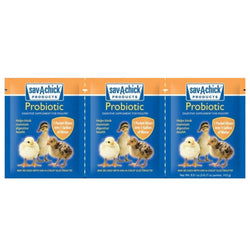5 rules for keeping multiple roosters
Back to blog

Roosters can be a challenge sometimes. Don't get me wrong--I love roosters! But they can be territorial and protective of what they regard as "their" hens. That's part of their charm, of course, but when they compete with one another too much, they can hurt each other, or even hurt the hens! When you have multiple roosters in your flock, that protective instinct can get out of hand.
Still, I currently have three roosters in my flock of 30, and that's my normal mode of operation. In addition to my Favauacana, I have a mixed breed named Francis, and a Black Copper Marans named Gerard. I tend to keep two or three roosters in my flock at a time--peacefully. If you want multiple roosters in your small flock, here are 5 simple rules to follow that will help keep the peace.

1. Have plenty of hens for each rooster. If you only have a flock of five or seven birds, you don't want two (or more!) of them to be roosters. Generally---and especially when you want to keep multiple roosters---there should be 10 or 12 hens for each male in your flock. That will enable the roosters to have plenty of hens each, without worrying too much about competition from their rivals, and it will also be enough so that the hens dont' get too overbred. When there are too few hens for each rooster, a hen can be mated too often, resulting in broken feathers, bare backs/necks, or even injuries.

2. Have plenty of space in your run. When you have multiple roosters, there will be the occasional squabble, and for the most part that's okay. Those squabbles can get dangerous if there's not enough space, though. If your birds are too crowded together---even when there are plenty of hens---you may see serious problems. With multiple roosters you will need more than the bare minimum of space. You'll want to double or even triple the minimum space per bird for your flock. If too many roosters compete in a confined space, testosterone-fueled aggression and territoriality can boil to a head. Remember, roosters don't have impulse control like (most!) humans do; someone could get hurt! If there is plenty of space, when one rooster becomes tedious in his showmanship and flirtation, generally, the others will just lead "their" hens to a respectable distance away, so they won't feel threatened by the boor and serious fights won't break out.
3. If you have neither plenty of hens nor plenty of space, you can keep multiple roosters together by having NO hens. This is an arrangement you might have, for example, if you keep a flock of roosters for exhibition (rather than having a flock of hens for the purpose of laying). With no hens to compete for, multiple roosters often live together in relative peace.
4. Raise them together in your flock. Roosters who are raised together establish a pecking order between them as they are growing up. Because they have already established that order, there is less incentive to fight when they are older and more likely to hurt one another by sparring. Alternatively, you can add new roosters to your flock relatively painlessly if they are raised by a hen in your flock, or if they are introduced to your flock when they are young, before reaching sexual maturity. It will be difficult to maintain the peace if you add an adult rooster to your flock that already has roosters, because that new rooster will be regarded as an invader---not just by the other rooster(s), but also by your hens!

5. Some roosters are too aggressive to get along with other roosters, no matter how ideal the conditions are. There are some breeds that tend to produce very aggressive roosters that are prone to fighting amongst one another, and other breeds with more genteel reputations. For example, game breeds often have aggressive roosters. Rhode Island Reds have notoriously aggressive roosters, too. We've also found that Easter Eggers and Ameraucanas don't always get along well with multiple roosters in the flock, either. That said, most backyard chicken breeds do fine in flocks with multiple roosters. Favorite breeds for roosters (and multiple roosters) include Salmon Faverolles, Plymouth Rocks, Marans, Orpingtons, Australorps, Silkies and Brahmas.
Do you have any tips for keeping multiple roosters--or any favorite breeds for roosters for the home flock? Please let us know your opinion in the comments below!












7 comments
I had a broody hen and decided to give her two eggs and see what happens. Well, they are both roosters! I have the two babies which are seven months old now, separated and living together with no hens. They are in the same area but separated. So far so good but who knows. I hope they can live together peacefully. Only time can tell.
Dora
I inherited 2 hens from next door. The first hen brooded until the chicks were about 7 weeks old and then either a hawk got her, or the owners disappeared her. 😢 so I took over the care, feeding and guidance of these 5 babies. I on the phone with my mom completely ignorant of what breed they are, so I used an app that helps to identify breeds and discovered they’re more than likely Japanese bantams, mixed with some Leghorn in there. Initially, all the crowing from next door (as in 10 feet away with a fence) drove me crazy. But after the first hen proudly marched her brood down the center of my backyard, I fell in love. We lost a total of 5 of the original 10 to hawks. And I’m thinking a hawk got mama too. Anyway, as it turns out, 4 of the remaining 5 are roosters for sure! And 1 is a hen. There are certain “tells” I’ve figured out – the color of the feet, the shape of the tail feathers, and an “extra” feather that points out on top of the roosters tail feathers. I have one – named Arnie, who has been an obvious rooster since 4 weeks old. He grew faster, he has orange feet, he is bossy, but not to the point of being dangerous, just gives a peck now and again to the other guys that he is the boss. He helps me keep order in the flock. So yes, I believe cockerels/roosters can co exist together peaceably as long as they’re treated right by the care taker. In other words, not left isolated, given directions, rewarded for good behavior, and praised a lot. I feel sorry for the lone pullet because she is left alone from the flock sometimes, other times the boys are very protective of her. Time will tell. They all know they’re names. And yes, there is a definite pecking order to the situation. Also, a rogue rooster came over the wall a few days ago, I thought he was a bully because he kept picking on my kids, (chicken kids) but as it turns out, one of my cockerels looks a lot like his girlfriend from next door, so he was attempting to mate with “her”, wow was he surprised to learn that “she” was a “he”, and then he pecked on my actual pullet, too young not old enough yet, not laying eggs so what’s the point? It’s been a week or so now, but my chicken kids have acclimated to this new guy who I believe was bullied next door, when all he wants to do is grow up, he has hormones raging and nothing to do about it! It can be done, but it definitely requires time – patience – creativity – and lots of love. Good luck! 😉
I got 7 silkie babies and they are now 6months 3 Roos ands 4 hens
2 of my Roos are more manly and I have now at 24 weeks seen them pec at each other. I’m so torn on what to do, are they just living life or are they gonna hurt each other. The Roo pecked my hens this morning. Nothing has happened that’s to aggressive but I’m trying to prepare for anything.
I was told for Silkie rooster, 4 hens to 1 rooster
We had 2 Silkie roosters and a bantam Cochin rooster and one day when we got home only one Silkie was left standing. That was with 7 bantam hens and 3 brown hens. So yeah, 1 rooster for 10 hens makes sense. We ended up getting rid of the Silkie too because we couldn’t tame the hens with him around.